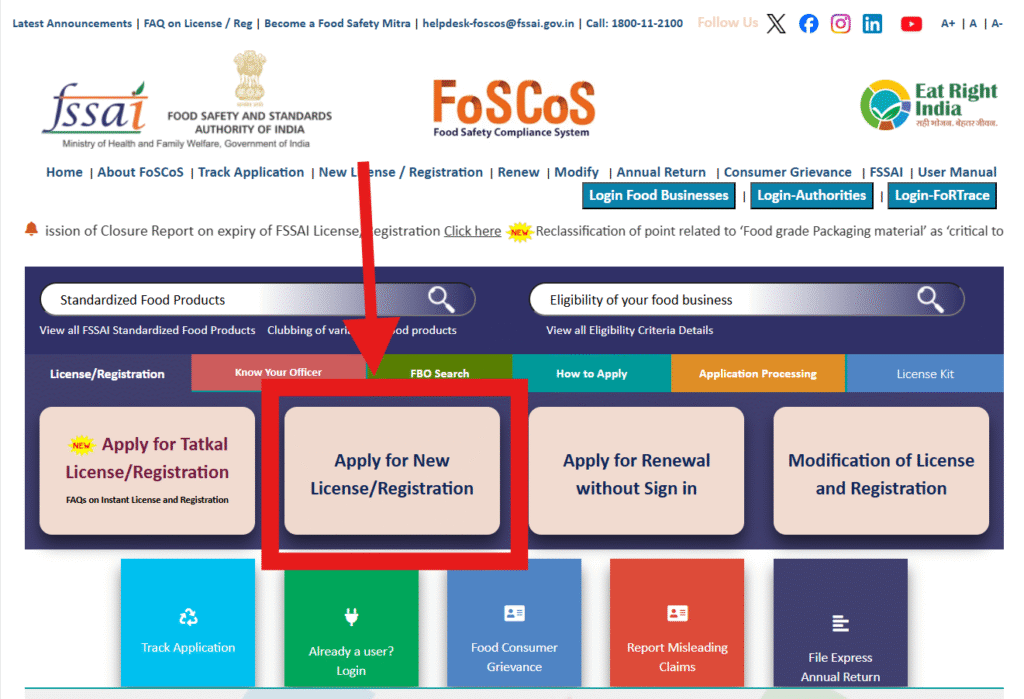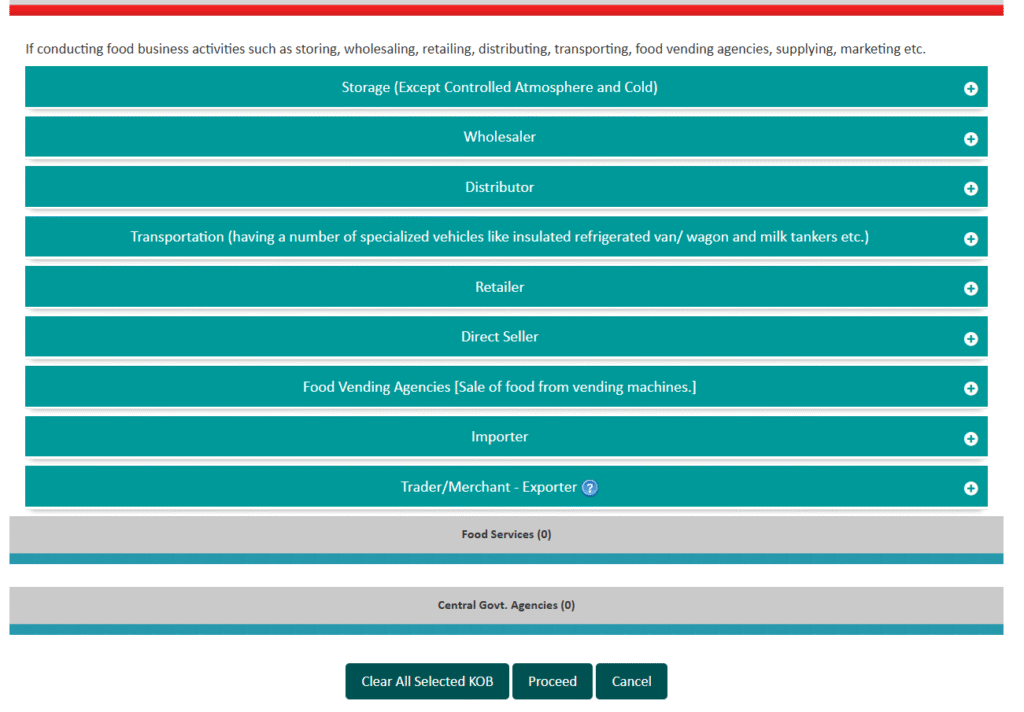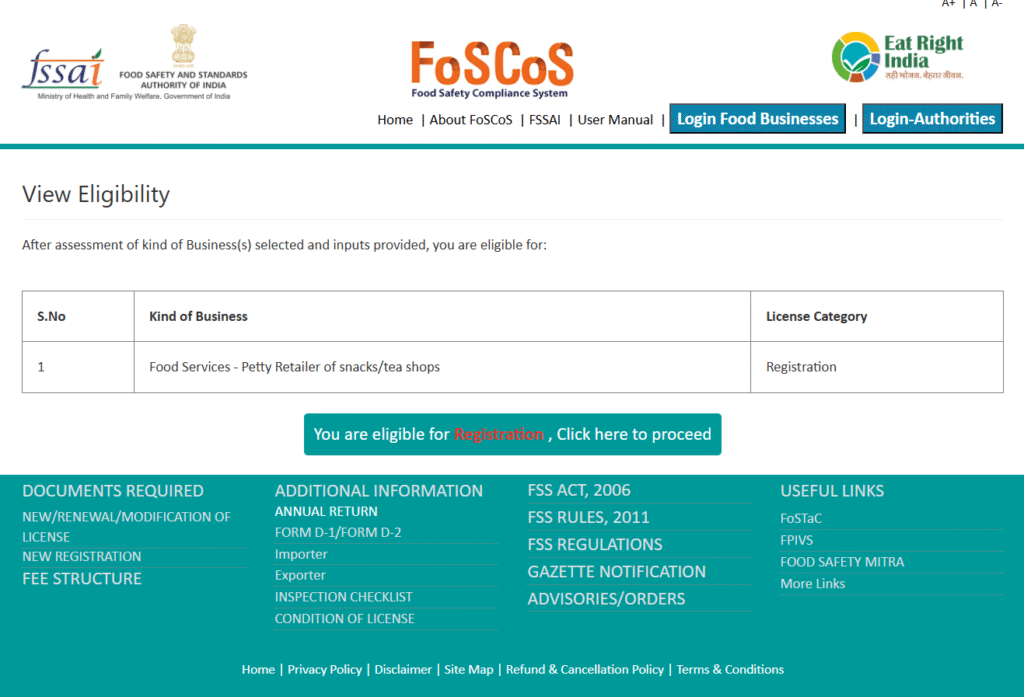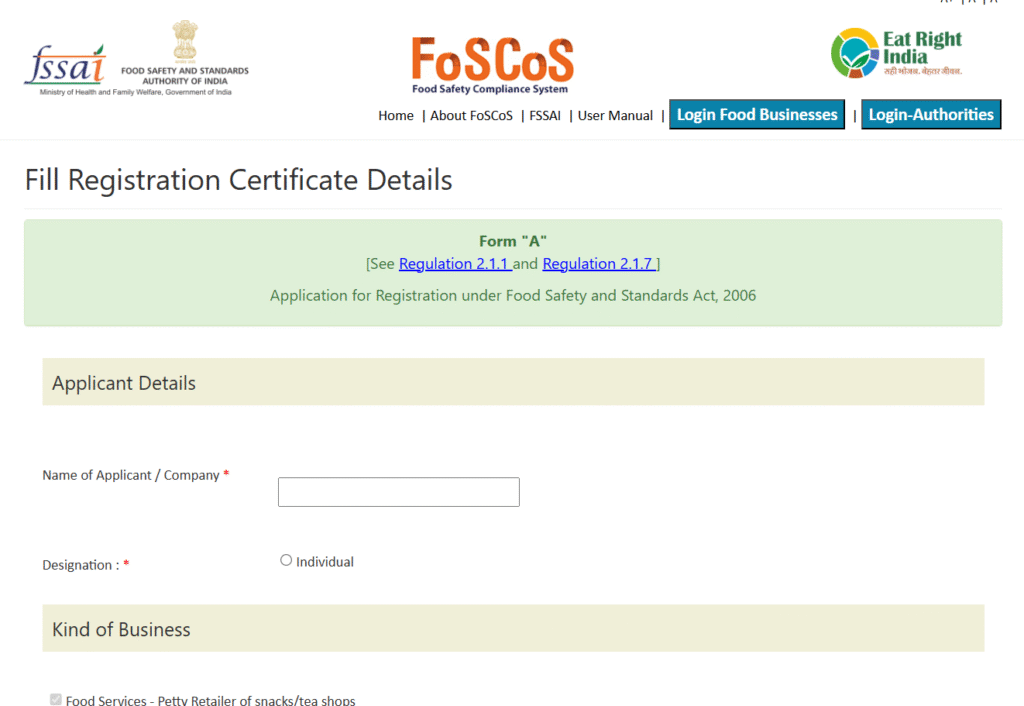Introduction
Whether you’re launching a home-based snack venture, running a small café, or exporting gourmet pickles overseas, obtaining your FSSAI registration is the very first—and non-negotiable—step toward building a credible, compliant food business in India. The Food Safety and Standards Authority of India (FSSAI) serves as the national watchdog for all things edible: from raw ingredients and additives to packaged products and catering services. Without the proper registration or license, you not only risk hefty penalties and legal hassles but also lose out on consumer trust and market access.
Why FSSAI Registration Matters
- Legal Compliance & Peace of Mind
Operating without FSSAI registration is tantamount to flying under the radar. Not only can authorities slap you with fines up to ₹5 lakh, but repeated non-compliance may even lead to business shutdown. By registering, you demonstrate adherence to the latest food-safety norms, keeping you firmly on the right side of the law. - Enhanced Credibility
In today’s competitive food landscape, shoppers—and potential B2B partners—scan labels, search for certifications, and vet suppliers. An FSSAI registration number on your packaging signals that you’ve met stringent safety benchmarks, boosting customer confidence and opening doors to platforms like e-commerce marketplaces and export councils. - Business Growth & Market Access
From local grocery stores to national supermarket chains, most institutional buyers now demand proof of FSSAI compliance before stocking products. Whether you aim to scale up regionally or tap into international markets, a valid FSSAI registration is your passport.
What You’ll Learn in This Guide
- Eligibility & Documentation: Who needs to register, and what papers you must gather.
- Portal Walkthrough: How to navigate India’s FoSCoS (Food Safety Compliance System) online portal from account creation through submission.
- Fees & Timelines: Exact fee structures for various business categories and typical approval windows in 2025.
- Troubleshooting Tips: How to avoid common errors—mismatched names, invalid file formats, payment failures—and what to do if your application stalls.
- Post-Approval Steps: Downloading your certificate, updating business details, and renewing on time.
By the end of this step-by-step walkthrough, you’ll have the confidence—and the complete checklist—to submit a flawless FSSAI application online. Let’s dive in!
What Is FSSAI Registration?
Before you begin the online application, it’s crucial to understand what you’re applying for—and which category fits your business. FSSAI issues two main types of authorizations:
- FSSAI Registration (Basic Registration)
- Who it’s for:
- Small-scale food businesses with an annual turnover of up to ₹12 lakh (e.g., home bakers, small kiosks, cottage industries).
- Businesses operating in a single state or territory without multiple premises.
- Key features:
- Simplest and most affordable category.
- Registration certificate valid for 1–5 years.
- Fee: ₹100 per year (flat rate).
- Who it’s for:
- FSSAI State License
- Who it’s for:
- Medium-sized businesses with turnover between ₹12 lakh and ₹20 crore.
- Units operating in one state but with larger production capacity or multiple outlets.
- Key features:
- More stringent eligibility criteria (e.g., food safety management plan, trained Food Safety Supervisor).
- Inspection by state food authority may be required.
- Fee varies by state and scale—typically ₹2,000 to ₹5,000 per year.
- Who it’s for:
- FSSAI Central License
- Who it’s for:
- Large-scale or high-risk businesses (turnover above ₹20 crore).
- Importers, exporters, large manufacturers, or businesses operating in more than one state.
- Food service operations in international airports, seaports, centrally protected areas.
- Key features:
- Requires a comprehensive Food Safety Management System (FSMS), HACCP plan or ISO 22000 certification.
- Centralized inspection by the Food Safety Commissioner of India.
- Fee: ₹7,500 to ₹75,000 per year, depending on turnover slab.
- Who it’s for:
Registration vs. License: What’s the Difference?
| Aspect | Basic Registration | State License | Central License |
|---|---|---|---|
| Annual Turnover | ≤ ₹12 lakh | ₹12 lakh – ₹20 crore | > ₹20 crore |
| Application Fee | ₹100/year | ₹2,000–₹5,000/year (state-wise) | ₹7,500–₹75,000/year (slab-based) |
| Validity | 1–5 years | 1–5 years | 1–5 years |
| Inspection Required | Generally no | Possible state-level audit | Mandatory central-level audit |
| Risk Profile | Low | Medium | High |
Tip: If you’re just starting and fall under the basic-registration criteria, go for the ₹100-per-year option to dip your toes in compliance without a heavy financial commitment. You can always upgrade to a state or central license as your business scales.
Why Choose the Right Category?
- Avoid Rejection: Selecting an undersized category (e.g., registering as basic when you should hold a state license) can lead to immediate rejection or later penalties.
- Optimized Cost: Overpaying for a higher-tier license (e.g., central license when a state license suffices) ties up working capital unnecessarily.
- Smooth Operations: Each category has its own set of documentation, inspection protocols, and renewal workflows. Knowing your category upfront ensures a smoother application process.
Eligibility & Documents Required
Before you log into the FoSCoS portal, ensure you have the right documents on hand and that you meet the eligibility criteria for your chosen category. Gathering and preparing these files in advance will save you time—and reduce the risk of application rejections.
1. Eligibility Criteria Recap
- Basic Registration
- Turnover ≤ ₹12 lakh per year
- Single-state operation, single premises
- State License
- Turnover between ₹12 lakh and ₹20 crore per year
- Single-state operation, one or multiple premises
- Central License
- Turnover > ₹20 crore per year
- Multi-state operation, import/export, or high-risk food category
2. Master Document Checklist
| Document | Who Needs It | File Format & Size |
|---|---|---|
| Form A / Form B | All applicants | PDF; ≤ 2 MB |
| Proof of Identity (Owner/Partners/Directors) | All applicants | PDF/Image (JPG/PNG); ≤ 1 MB |
| Proof of Address (Premises & Applicant) | All applicants | PDF/Image; ≤ 1 MB |
| Photo of Food Business Premises | All applicants | JPG/PNG; ≥ 500×500 px; ≤ 1 MB |
| List of Food Products | All applicants | PDF; plain text list |
| Blueprint / Layout Plan of Premises | State & Central License only | PDF; architect’s drawing |
| Food Safety Management Plan (FSMS) | State & Central License only | PDF; HACCP or ISO 22000 plan |
| Proof of Turnover (CA Certificate / ITR) | State & Central License only | PDF; current financial year |
| Partnership Deed / MOA & AOA | Partnership firms / Companies | PDF; registered document |
| Authority Letter | In case of consultant filing on your behalf | PDF; signed by proprietor/director |
| Affidavit (if applicable) | When premises is rented or consent needed | PDF; notarized |
3. How to Prepare & Organize Your Files
- Scan to PDF
- Use a scanner or a mobile-app (CamScanner, Adobe Scan) to convert multi-page documents (MOA/AOA, turnover proofs) into a single PDF.
- Ensure text is legible; crop out extraneous borders.
- Image Quality & Naming
- Photos of premises and IDs should be clear, with all corners visible.
- File names should follow a clear convention, e.g.,
PAN_Card_John_Doe.pdf,Shop_Photo_Front_View.jpg.
- Size & Format Checks
- Compress PDFs (Smallpdf, ILovePDF) to stay under 2 MB without losing readability.
- Convert color photos to RGB JPEGs; avoid CMYK (common in print) as some portals reject these.
- Document Versioning
- If you’re employing consultants, confirm they haven’t uploaded draft versions.
- Maintain a local “FSSAI Docs” folder with subfolders for each document type; back it up to cloud storage.
- Translation & Notarization
- If any document is in a regional language, provide a notarized English translation.
- Affidavits (for rented premises) must be signed and notarized—digital signatures are accepted if they’re compliant with the e-Sign framework.
4. Final Pre-Submission Checklist
- All files are correctly named and formatted.
- PDFs open without errors; images display fully.
- You have clear, recent photographs of your premises (exterior and interior).
- Layout plans and FSMS documents are up-to-date with your current operations.
- Authorization letters (if any) are signed by the proprietor or managing director.
With these documents organized and verified, you’re now ready to create your FoSCoS account and begin the step-by-step application.
Step 1: Setting Up Your FoSCoS Account
The Food Safety Compliance System (FoSCoS) portal—https://foscos.fssai.gov.in your one-stop gateway for all FSSAI registrations and licenses. Follow these steps to create your account and lock in your user credentials.
1. Navigate to the Portal & Choose “New User Registration”
- Open your browser and go to:
https://foscos.fssai.gov.in - On the homepage, click Apply for New License/Registration.
- You’ll land on the “Registration” screen.

2. Fill in Kind of Business (KoB)
First of all you’ll have to select your Kind of business from the list given on the Portal

Upon selecting the KoB, on the next page you’ll automatically see which kind of registration or license (State/Central) your business is eligible to apply for.

3. Fill in the Application Form and Upload Documents
You’ll get to the page with the required form you’d need to submit, automatically depending your KoB.
Just fill in the details about your business, products & upload the required docs.

5. Review & Submit Initial Registration
- Double-check all entries for typos or mismatches.
- Read and agree to the portal’s Terms & Conditions checkbox.
- Click “Register” or “Submit” at the bottom.
You should see a confirmation screen saying “Registration Successful” along with your FoSCoS User ID. Note this down—the system will also email it to you.
6. Logging In for the First Time
- Return to the FoSCoS homepage.
- Enter your Username and Password, then click “Login”.
- Complete any additional OTP verifications if prompted.
You’re now inside the FoSCoS dashboard, ready to start your application under “My Applications”.
Step 2: Tracking Your Application & Common Troubleshooting
After submitting, your application enters the review queue of the relevant Food Safety Authority. Here’s how to track its progress and what to do if you hit a snag.
1. Monitoring Application Status
- Login & Navigate
- Return to your FoSCoS dashboard and click “My Applications.”
- Locate your application by its Reference No. (e.g.,
FSSAI/2025/ABCDE) in the list.
- Status Indicators StatusMeaningDraftYou began but did not submit the application.SubmittedYou’ve submitted; awaiting initial verification.Under ProcessOfficials are reviewing documents and details.Additional Info RequiredThe Authority has requested clarifications or corrections.Payment PendingYour fee is unpaid or unverified (for bank challan users).ApprovedRegistration/license has been granted.RejectedApplication has been denied; a reason will be provided.
- Email & SMS Alerts
- The portal automatically sends updates to your registered email and mobile.
- Ensure you whitelist
noreply@foscos.fssai.gov.into avoid missing critical notices.
- Expected Timelines (2025 Estimates) Application TypeAverage Turnaround TimeBasic Registration5–7 working daysState License15–20 working daysCentral License30–45 working days
Tip: If your application remains in “Under Process” beyond the average window, prepare to follow up proactively (see troubleshooting below).
2. Responding to “Additional Info Required”
If the authority flags missing or incorrect information, you’ll see your status change to “Additional Info Required”, along with a comment. Here’s how to handle it:
- Review the Comment Carefully
- Click “View Remarks” to see which section and what issue has been flagged (e.g., “Uploaded ID proof is blurred,” or “Turnover proof mismatches application details”).
- Prepare the Corrected Document
- For simple mismatches (name spelling, dates), a scanned letter on company letterhead explaining the discrepancy often suffices.
- For file issues (size, format), re-save or compress to the required spec.
- Resubmit the Attachment
- In “My Applications,” click “Action” → “Provide Additional Info.”
- Upload the revised file(s) in the indicated slot.
- Add a brief note in the comments field: e.g., “Replaced ID proof with higher-resolution scan.”
- Click “Submit.”
- Confirmation & New Timeline
- Upon re-submission, the status reverts to “Under Process,” and the clock resets for the average review time (usually 3–5 working days for basics, longer for licenses).
3. Common Issues & Fixes
| Issue | Cause | Solution |
|---|---|---|
| OTP Not Received | Network/SMS filter issues | Resend OTP; try a different mobile number if issue persists. |
| Invalid File Type / Size Error | Wrong format or oversized document | Convert to PDF/JPEG; compress with Smallpdf or similar. |
| Mismatch in Name/Address | Details on application don’t match documents | Upload an affidavit or explanatory letter; correct fields via “Additional Info.” |
| Payment Status Stuck on “Pending” | Bank challan delay; gateway glitch | Wait 48 hours for challan; contact support if online payment failed. |
| Login Failure After Registration | Incorrect credentials / expired link | Use “Forgot Password”; check email for activation link. |
| Application Rejection Without Clear Reason | Rare system glitch or incomplete remark | File a grievance via the portal’s “Contact Us” or write to state FSSAI authority with your Reference No. |
Pro Tip: Keep a log (spreadsheet or simple doc) of each action you take—date of upload, remarks, and follow-up dates—so you can reference it in any escalation.
4. Downloading Your Certificate
Once your application status shows “Approved,” you can download your FSSAI certificate:
- In “My Applications,” click “Download Certificate” next to the approved application.
- The certificate (PDF) opens in a new tab; save it as
FSSAI_Certificate_<YYYY>.pdf. - Print and display the registration number on your product labels, invoices, and marketing collateral as required.
Reminder: Your certificate will show the Validity Period (e.g., 01-JAN-2025 to 31-DEC-2027). Note this for timely renewal.
5. Renewal & Amendments
- Renewal Timeline:
- You can renew 90 days before expiry. Late renewal invites a penalty of 10%–25% of the fee.
- Renewal Process:
- Log in, go to “My Licenses,” and click “Renew.”
- Update any changed details (address, turnover).
- Upload fresh documents if required (e.g., new CA turnover cert).
- Pay the renewal fee (same slab as initial application).
- Submit and monitor status just like a new application.
- Amendments (Change of Address/Products):
- Choose “Amendment Application” under “My Applications.”
- Select the amendment type, upload supporting docs, and pay a nominal fee.
Step 3: Key Takeaways & Printable Checklist
To recap, here are the essential milestones for your FSSAI online registration journey—print this and keep it by your desk as you work through each step:
| ✅ Task | Details / Notes |
|---|---|
| Decide Your Category | Basic (≤₹12L), State (₹12L–₹20Cr), or Central (>₹20Cr) |
| Gather Documents | Form A/B, ID proofs, address proofs, FSMS/HACCP, etc. |
| FoSCoS Account Setup | Username, password, email & mobile OTP verification |
| Complete Application Wizard | Sections A–E: Business details, premises, categories, uploads |
| Pay Fees | Online or challan; verify payment status |
| Submit & Note Reference No. | Screenshot and save FSSAI/YYYY/ABCDE |
| Track Status | “Under Process” → “Approved” (5–45 working days) |
| Respond to Queries | Handle “Additional Info Required” promptly |
| Download Certificate | Save as FSSAI_Certificate_<Year>.pdf; display number |
| Schedule Renewal | Renew 90 days before expiry; avoid late fees |
Quick Tip: Store all correspondence and screenshots in a dedicated folder (cloud backup recommended).
FAQs
Q1: What is FSSAI registration, and who needs it?
A1: FSSAI registration is a mandatory authorization from the Food Safety and Standards Authority of India for anyone involved in manufacturing, processing, storing, distributing, or selling food.
- Basic Registration (Form A) is for small businesses (turnover ≤ ₹12 lakh).
- State License (Form B) covers medium businesses (turnover ₹12 lakh–₹20 crore).
- Central License (Form B) is required for large/high-risk businesses (turnover > ₹20 crore) or multi-state operations.
Q2: How much does it cost to register with FSSAI?
A2:
- Basic Registration: ₹100 per year
- State License: ₹2,000–₹5,000 per year (varies by state)
- Central License: ₹7,500 per year (slab-based on turnover)
Q3: What documents are required for an online FSSAI application?
A3: At minimum, you’ll need:
- Duly filled Form A (basic) or Form B (license)
- Proof of identity (PAN card, Aadhaar, or passport)
- Proof of address (utility bill or rental agreement)
- Photo of your business premises
For state and central licenses, you’ll also need a layout plan, FSMS/HACCP documents, turnover proof (CA certificate/ITR), and company registration documents (MOA/AOA).
Q4: How long does the FSSAI approval process take?
A4:
- Basic Registration: 5–7 working days
- State License: 15–20 working days
- Central License: 30–45 working days
Delays can occur if the authority requests additional information or document clarifications.
Q5: Can I apply for FSSAI registration myself, or do I need a consultant?
A5: The FoSCoS portal is designed for self-service. You can complete the entire process—registration, document upload, and payment—without a consultant. If you prefer expert help, consultants can assist, but they’re not mandatory.
Q6: How do I renew or amend my FSSAI registration?
A6:
- Renewal: Log in to FoSCoS up to 90 days before expiry, select “Renew,” update any changed details, upload fresh documents if needed, pay the renewal fee, and submit.
- Amendments: In “My Applications,” choose “Amendment Application,” select the change type (e.g., address or product list), upload supporting documents, pay the nominal fee (₹100–₹500), and submit.
Final Thoughts
Securing your FSSAI registration isn’t just a regulatory checkbox—it’s a foundational step that protects your business, builds customer trust, and unlocks growth opportunities. By following this detailed, 4-step guide and using our printable checklist, you’ll avoid common pitfalls and sail smoothly through the process.
Once you’ve got your certificate in hand, don’t forget to leverage FoodCompli AI for:
- Label Generation: Auto-create FSSAI-compliant labels in seconds.
- Additive & Ingredient Checks: Ensure your formulations meet global standards.
- Compliance Audits: Run self-checks to stay audit-ready year-round.
Ready to simplify your food-compliance workflow?
➤ Explore Foodcompli
Here’s to a compliant, credible, and thriving food business!
Was this guide helpful? Let me know in the comments below or reach out if you have any questions!
